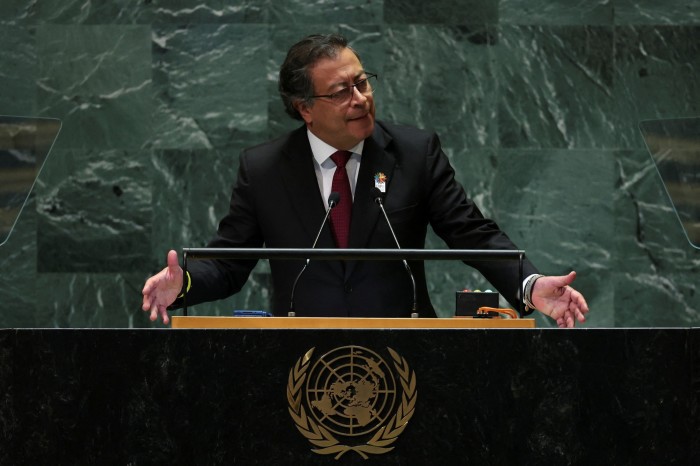Colombia battles to diversify economy away from oil and gas

Colombia has been pushing to wean its economy off fossil fuels since it installed its first leftist president more than two years ago. But it has struggled to move more into agriculture, tourism, and renewable energy industries.
“Without a doubt, in order to substitute the revenues from fossil fuels, the economy must be diversified,” says Andrés Camacho, minister of mines and energy.
President Gustavo Petro’s administration has stopped issuing new oil drilling and exploration contracts and, in December last year, became the first significant oil and coal producer to sign up to the Fossil Fuel Non-Proliferation treaty, which promotes the elimination of fossil fuel extraction worldwide.
However, oil and coal exports still make up around half Colombia’s export revenues, generating $24.7bn last year, while tourism and agriculture brought in about $17.5bn. And, even though the $7.4bn tourism industry has expanded 12.8 per cent since 2022, it remains a long way off generating an income similar to that of fossil fuels.

Some observers have questioned the government’s insistence on abandoning extractive industries at a time when oil prices are high.
Other South American nations, such as Brazil and Guyana, are developing fossil fuel industries as well as promoting environmental initiatives.
“The fact is that, defending oil and gas and defending alternative energies, does not mean that you cannot develop tourism and agriculture at the same time,” says Juan Carlos Echeverry, a former finance minister and president of state-controlled oil company Ecopetrol, who is now a critic of the government. “I don’t see that there is a dilemma, as both things can be done, as they are in the US and Brazil.”
Colombia’s economy is lagging, with growth this year projected at 1.9 per cent, below the IMF’s regional projection of 2.1 per cent. Year-on-year inflation in September accelerated to 6.1 per cent. Petro now plans to issue the national spending plan for 2025 by decree, following an impasse with lawmakers over budget financing.
Meanwhile, agricultural exports are set to increase 8 per cent this year, the government said in August. The forecast follows a 12.8 per cent decline in 2023. Before that, the sector had seen steady growth.
Petro, once a guerrilla member who has often criticised the country’s private sector, is committed to reaching net zero emissions by 2050 and has said Colombia should export green energy.
In 2022, 66 per cent of the country’s grid was generated by hydropower, 32 per cent by fossil fuels, and 2 per cent by wind and solar.
Now, the government predicts that by 2027, it will be 50 per cent hydro, 26 per cent wind and solar, and 24 per cent fossil fuels. Energy minister Camacho notes that 85 solar farms were brought online in the past year.
But critics have hit out at the government for not working with renewable energy companies to overcome issues with local communities.
Enel, the Italian utility, last year abandoned construction of a landmark wind farm project after failing to reach an agreement with local indigenous communities over the land to be used for transmission lines.
“Projects need to be sustainable not only from a social standpoint but an economic one,” said Eugenio Calderón, who heads Enel Green Power in Colombia and Central America, at the time.
The project would have added 205MW of capacity to Colombia’s 21GW grid but now sits unfinished in a windy region of the La Guajira peninsula, which juts out from the northern tip of South America into the Caribbean.
However, Grupo Energía Bogotá, whose principal shareholder is the city of Bogotá, is building transmission lines that are expected to come online in two phases over the next two years, connecting other wind farms to the grid — something Camacho says reflects lessons learnt from the experience with Enel.
“We have developed a government-to-government conversation with indigenous authorities and have gained a deeper understanding of their customs, their practices, their systems of thought,” Camacho explains. “It is an opportunity to develop what we have identified as a fair transition.”

Alexandra Hernández, the president of Colombia’s renewables association, says the country needs to continue to diversify its grid, which is vulnerable to drought as 70 per cent of energy is generated in hydroelectric dams.
The government has warned of energy shortages in 2028 if more projects are not brought online, with demand projected to outstrip supply by three times.
“That’s where renewables come in because they can come online much quicker,” says Hernández, adding that the country should not shift abruptly away from fossil fuel extraction.
“As long as the world continues to consume gas and oil, it is unnecessary for Colombia to sacrifice the less than 1 per cent of the global oil supply in which it participates.”
Zelestra, a Spanish renewable energy group, is investing in Colombia, and in September inaugurated a $200mn solar farm with capacity to generate 100MW.
Chiara Gasparrini, the group’s vice-president for business development in Latin America, says that changes to the regulatory framework under the Petro government have made it a more attractive place to invest in renewables than other solar and wind rich countries in the region, such as Peru and Ecuador.
Approvals can take too long, though. “Often, the time required for permits . . . is not exactly what would be required to make many projects viable within the timeframe of government legislation,” she says. “But it is certainly something that is being worked on.”
#Colombia #battles #diversify #economy #oil #gas




